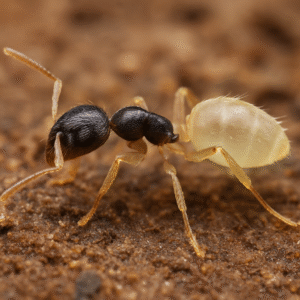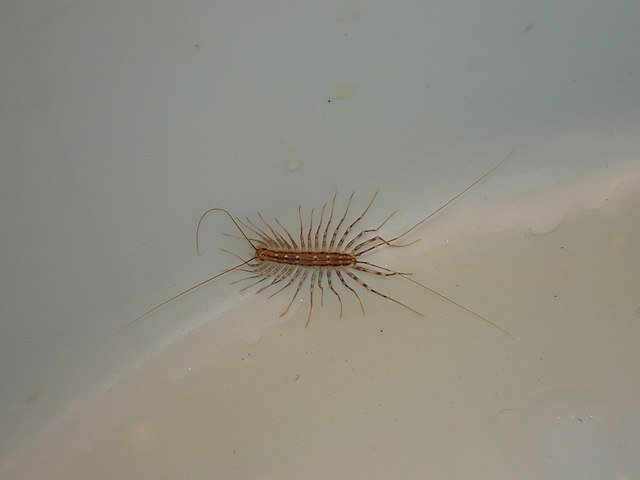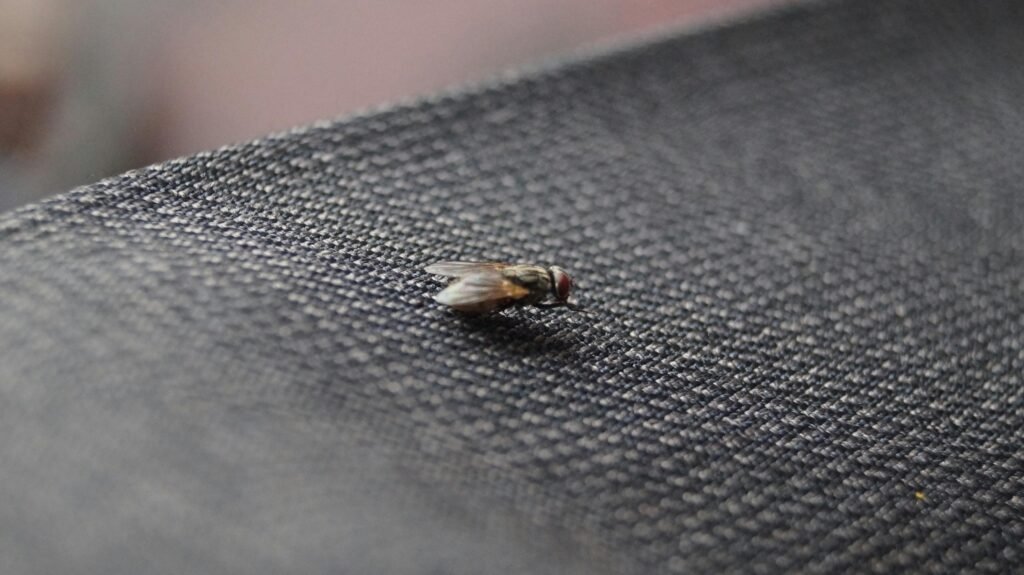Ghost Ants (Tapinoma melanocephalum): Tiny Intruders with a Big Impact
 When it comes to household pests, few species are as elusive and frustrating as the Ghost ant (Tapinoma melanocephalum). Named for their almost transparent legs and abdomen, these ants seem to appear out of nowhere and vanish just as quickly. While their size makes them easy to overlook, infestations can grow rapidly and disrupt homes, hospitals, and businesses.
When it comes to household pests, few species are as elusive and frustrating as the Ghost ant (Tapinoma melanocephalum). Named for their almost transparent legs and abdomen, these ants seem to appear out of nowhere and vanish just as quickly. While their size makes them easy to overlook, infestations can grow rapidly and disrupt homes, hospitals, and businesses.
Unlike more familiar ants such as Carpenter ants (Camponotus spp.) or Fire ants (Solenopsis invicta), Ghost ants don’t cause visible structural damage or deliver painful stings. However, their presence indoors is a serious nuisance, and they can contaminate food surfaces, transmit pathogens, and create persistent infestations that are difficult to eliminate.
This article explores the biology, global spread, health concerns, and management of Ghost ants, along with cultural insights and practical FAQs to equip homeowners and professionals with the knowledge needed to deal with these pests.
Identification
Ghost ants are among the smallest household ants. Key features include:
Size: Workers are only 1.3–1.5 mm long.
Coloration: The head and thorax are dark brown, while the legs and abdomen are pale or translucent, giving them a “ghostly” look.
Antennae: 12 segments, without a distinct club.
Odor: When crushed, Ghost ants emit a distinct, coconut-like smell—similar to Odorous house ants (Tapinoma sessile), but milder.
Colony Structure: Polygynous (multiple queens per colony), which allows colonies to split and expand quickly.
Because of their translucent appearance, they can easily be confused with Pharaoh ants (Monomorium pharaonis), another small invasive pest, but careful observation under magnification can confirm identification.
Biology and Ecology
The biology of Ghost ants explains much of their pest status.
Diet: They are omnivorous, feeding on sweets, proteins, grease, and even insects such as Fruit flies (Drosophila spp.). Indoors, they forage on sugary drinks, honey, and baked goods. Outdoors, they tend to feed on honeydew from aphids and scale insects.
Colony Behavior: Colonies are mobile and opportunistic. Workers create temporary nests in soil, potted plants, wall voids, behind baseboards, or under kitchen appliances.
Reproduction: Because colonies are polygynous, even small infestations can rapidly multiply. Budding (splitting of colonies) makes control more complicated—when disturbed, colonies fragment, leading to multiple smaller nests.
Activity Patterns: Ghost ants prefer warm, humid environments. They are especially problematic in tropical and subtropical regions but can survive indoors in temperate climates thanks to heating systems.
Global Distribution
Tapinoma melanocephalum is native to tropical Asia or Africa (its exact origin is debated), but today it is a true global tramp species.
Americas: Common throughout Florida, Texas, the Caribbean, and Central and South America.
Europe: Found indoors in heated buildings, especially greenhouses.
Asia and Pacific: Widespread in India, Southeast Asia, Japan, and Pacific islands.
Africa: Present in multiple countries, thriving in coastal urban environments.
Their spread is largely due to human commerce, especially the movement of potted plants, nursery stock, and goods stored in shipping containers. This makes them similar in distribution pattern to Cockroaches (Blattodea) and Bed bugs (Cimex lectularius), which also hitchhike easily.
Risks and Damage
Ghost ants may not chew wood like Termites (Isoptera) or sting like Fire ants, but they pose significant risks:
Food Contamination
They forage in kitchens, restaurants, and hospitals, contaminating food and surfaces with pathogens.Disease Transmission
While not primary vectors, studies have found Ghost ants carrying bacteria such as Salmonella, Staphylococcus, and Pseudomonas. In sensitive environments like hospitals, this is a serious concern.Infestation Spread
Their polygynous colonies can fragment during control attempts, leading to rapid reinfestation.Structural Inconvenience
Colonies nest inside wall voids, electrical outlets, and under flooring, making them hard to detect and remove.Psychological Stress
Continuous sightings of tiny ants crawling across counters, electronics, and food can cause significant stress in households and businesses.
Signs of Infestation
Ghost ant infestations are subtle but detectable:
Foraging Trails: Workers move in erratic but visible lines, often along baseboards or countertops.
Small Size and Transparency: Colonies can go unnoticed until populations become dense.
Nest Locations: Check moist areas, potted plants, bathrooms, or behind kitchen cabinets.
Odor on Crushing: A faint coconut-like smell confirms the presence of Tapinoma species.
Because they nest both indoors and outdoors, infestations may require monitoring across multiple environments.
Control Methods
Eradicating Ghost ants is challenging due to their colony structure. Standard sprays often fail and may worsen the problem. Key strategies include:
1. Sanitation
Eliminate food residues, sugary spills, and grease.
Store food in sealed containers.
Regularly clean under appliances and furniture.
2. Exclusion
Seal cracks around doors, windows, and utility lines.
Remove excess moisture by fixing leaks and improving ventilation.
3. Baiting
Use slow-acting ant baits (gel or liquid formulations) with carbohydrates or proteins, depending on the colony’s foraging preferences.
Baits must be placed along trails; improper placement reduces effectiveness.
4. Professional Intervention
In hospitals or large facilities, licensed pest control professionals should handle infestations to avoid fragmentation.
Advanced Approaches
For persistent infestations, advanced integrated pest management (IPM) may be necessary:
Non-repellent Insecticides: Modern products allow ants to transfer active ingredients through trophallaxis (food sharing), targeting hidden queens.
Biological Insights: Some studies suggest that Ghost ants’ reliance on honeydew could be disrupted by controlling aphid and scale insect populations.
Monitoring Devices: Sticky traps and pheromone-based monitors help track colony spread.
Heat and Moisture Control: Adjusting humidity levels indoors may reduce Ghost ant survival, especially in temperate climates.
Cultural and Historical Context
Ghost ants, like many “tramp ants,” highlight the global nature of pest problems. Their ability to travel unnoticed in trade reflects the challenges of globalization and urban density.
In tropical cultures, Ghost ants are sometimes dismissed as minor annoyances compared to Mosquitoes (Culicidae) or Cockroaches, but in Western pest management literature, they are classified as major household pests.
Interestingly, their coconut-like odor has led to comparisons with Odorous house ants, and in some regions, homeowners colloquially call them “sugar ants” due to their sweet tooth.
FAQ
Q1. How can I tell Ghost ants apart from Pharaoh ants?
Ghost ants have a dark head and translucent abdomen, while Pharaoh ants are yellow to light brown overall.
Q2. Do Ghost ants bite humans?
No, they do not bite or sting. Their nuisance lies in contamination and colony persistence.
Q3. Can Ghost ants survive outdoors in cold climates?
Outdoors they die in cold winters, but they thrive inside heated buildings year-round.
Q4. What food attracts Ghost ants most?
Sugary substances—honey, syrup, soda, and fruit—are preferred, though they will switch to proteins as needed.
Q5. Why do Ghost ant infestations spread after spraying insecticide?
Sprays often kill only foragers, causing colonies to split into multiple new nests (budding).
Q6. Are Ghost ants dangerous in hospitals?
Yes, because they can carry bacteria between waste areas and sterile environments, increasing infection risks.
Final Thoughts
The Ghost ant (Tapinoma melanocephalum) is one of the most persistent and frustrating invasive ants worldwide. Their tiny size, translucent appearance, and habit of fragmenting colonies make them difficult to eliminate once established indoors. Unlike larger pests such as Carpenter ants (Camponotus spp.) or nuisance birds like Pigeons (Columba livia), Ghost ants may not cause visible structural damage, but they disrupt households, contaminate food, and complicate hospital sanitation.
Effective management requires more than quick fixes. Success depends on a combination of sanitation, baiting, exclusion, and professional intervention when infestations spread beyond household control. Understanding their biology and global spread also helps explain why they are such a dominant urban pest across tropical and temperate regions alike.
For homeowners and professionals, the key lesson is persistence: Ghost ants thrive where conditions allow them to. Remove their food sources, disrupt their nesting sites, and apply targeted control, and the “ghosts” will eventually fade.
Disclaimer
This article is for informational purposes only. Pest control laws and approved chemicals vary by country. For best results and legal safety, we strongly recommend contacting a licensed pest control professional in your local area. Always make sure that the pest control technician is properly certified or licensed, depending on your country’s regulations. It’s important to confirm that they only use approved products and apply them exactly as instructed on the product label. In most places in Europe, UK, or USA, following label directions is not just best practice—it’s the law.
Author Bio
Nasos Iliopoulos
MSc Agronomist & Certified Pest Control Expert
Scientific Director – Advance Services (Athens, Greece)
Licensed Pest Control Business – Ministry of Rural Development & Food (GR)
References
Wikipedia – Ghost Ants, Tapinoma melanocephalum
Penn State Extension – Common pest species of ants


